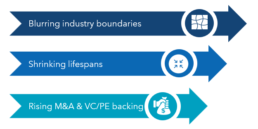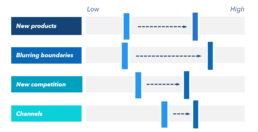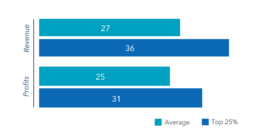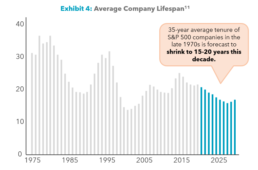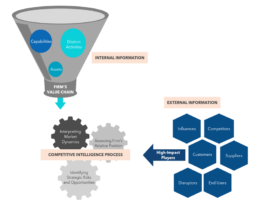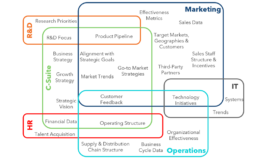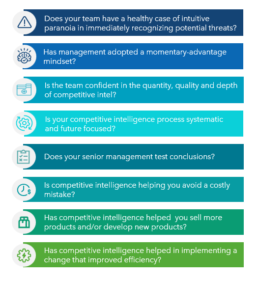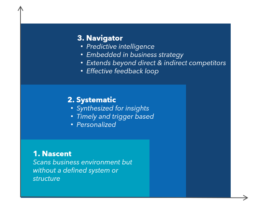Introduction
90% of businesses say their industry has become more competitive in the last three years (1)
Competition is an important facet of business world, and the process of seeking growth is a continuous one. One should never stop trying to win new customers or retain existing ones. After all, competitors are always trying to win your customers over, especially in mature markets.
As it is rightly said – It is easier to fight the enemy you know than one you don’t. Yet, companies find it challenging to take on familiar opponents, whose ambitions, strategies, weaknesses, and strengths resemble their own.
Business leaders should compare their game plans and prowess by closely anticipating competitor moves, value proposition, pricing strategies, product bundling etc. with their doppelgängers and later, investigate indirect and surging competitors to develop an informed and proactive plan to protect and gain their “size of the pie”.
In this paper, we share the need for insightful and actionable competitive intelligence, where firms usually go wrong, and how to successfully gather & leverage competitor intelligence to win in the marketplace!
Exhibit 1. Reasons for Increasing Competition
Competitors cannot be taken lightly
Competition has grown rapidly, especially in the Financial Services, Information Technology, Healthcare, and Retail sectors, as these industries are evolving rapidly and are being constantly fueled by Private Equity and Venture Capital firms.
1. Blurring Industry Boundaries
Although never a straightforward task, ‘drawing of lines’ between industries is becoming even more difficult today as ecosystems have become fluid and porous, operating across verticals and channels. Platform companies like Amazon, Google, Netflix, and Uber disrupted multiple industry verticals and began breaking down the boundaries with their innovative business models, products, services and channels.
With Apple’s recent entry into consumer credit through its partnership with Goldman Sachs (having issued roughly $10B in credit to card holders)(2) and Barclays teaming up invoice insurance provider Nimbla in the UK to offer its small-business customers access to insurance for individual invoices (3), it seems that large firms are making significant moves into previously uncharted industries.
Such partnerships — focusing on payments, mortgages, P&C insurance, brokerage services, and investment products — generated more than $70B in revenues in the U.S. alone in 20194. Similar partnerships are likely to disrupt the industry ever so more in near future.
Exhibit 2. Future Trends in Market Boundaries (5)
2. Shrinking Product and Company Lifespans
Long-term product ‘cash cows’, which stay in a company’s portfolio for several years, are becoming a thing of the past.(6) Today, a significantly larger share of a typical company’s revenue, is derived from new products and enhancements launched within the past three years (see Exhibit 3). The collapse of this lifespan has led to the norm of upgrading products and services every few years — otherwise, risking being surpassed by competitors.
The need of the hour is for firms to not rely on “too big to fail” ideology. The harsh reality is that 75% of the S&P 500 companies are likely to disappear by 2027, (7) and the biggest reasons for this are their inefficiency in managing themselves and serving their clients.
3. Rising M&A and VC/ PE Investments
Financial services deals in Private Equity have grown on the back of strong returns, including a multiple of 2.2x of invested capital in recent years (8). With Stripe raising $600M at a $36B valuation from VC valuations, and Intuit acquiring Credit Karma at $8.1B , the industry appears to be growing more rapidly than ever. (9)
With such deep pockets, business expertise, guidance, consultancy, and industry connections behind them, the smaller niche firms are able to accelerate at faster rates.
Exhibit 3. Contribution from products launched in past 3 years (10)
Exhibit 4. Average Company Lifespan (11)
The Need for Intelligence
Today, 87%+ of organizations are classified as having low business intelligence and analytics maturity. (12) In our experience, this is driven by the following reasons:
1. Monitoring is not ‘Intelligence’
The biggest misconception about competitive intelligence is the assumption that it is ‘information’ about competitors. Tracking tactical marketing/product information and press releases does not offer the full benefit of competitor intelligence.
One previously successful company that fell victim to inadequate intelligence is Nokia, the global leader in mobile phones in the late 1990s and early 2000s. With the arrival of the Internet, it was clear to other mobile operators how data, not voice, was the future of communication. However, Nokia continued to focus on hardware and not profit from the drastic change in user experience. In 2008, Nokia finally made the decision to compete with Android, but it was too late. Its products weren’t competitive, leading it to Nokia losing its prime position in the market space.
Exhibit 5 below depicts our recommended approach to distilling competitive intelligence.
The most essential part of competitive intelligence is to separate signal from noise, distil the plethora of information to insights, and then incorporate it into your go-to-market and functional strategies.
Exhibit 5. Recommended Competitive Intelligence process
2. Shaping your Strategy
Market research alone is $20 billion industry. Specific competitor information is another $2 billion (13). The paradox is that companies spend millions acquiring competitive or market “intelligence” but never question or re-visit the actual use of this information in branding, product, R&D, marketing, sales, purchasing or any other function. Executive management implicitly assume the information is being used effectively.
Personalization and timeliness are key to making competitor intelligence valuable. Ideally, 15-20% of the time is spent in planning, 30-35% in the actual gathering intelligence, and ~50% in the personalization (see Exhibit 6 for the distinct needs of each function), synthesis and strategy development.
Exhibit 6. Valuable Intelligence for each Business Function
3. The Right Stuff
Competitive research continues to be extremely time-consuming. Most researchers struggle for the following reasons:
- Inadequate questioning-
Several researchers limit themselves to what they read in the public domain and through marketing/PR updates from competitors. On the surface, most of this can sound like business as usual but everything requires vetting, triangulation and distillation. The age old technique of asking the ‘5 Whys’ can often uncover the motivations and strategies behind these events. - Information overload vs. relevance-
Due to limited time and plethora of publicly available information, firms often depend on industry reports. However, these are often high-level and not bespoke enough to be actionable. They are also usually not insightful, after-the-fact, and may have a myopic view of the competition. - Personal bias-
Often, market research teams may omit information that does not support their views, knowledge base and beliefs, thereby making the entire process misleading. Rather than being omitted, such information should be further vetted for insights.
Exhibit 7. Is your Competitive Intelligence Process efficient?
What is Your Maturity Level?
Exhibit 8. Maturity of Competitive Intelligence Capability
Level 1. Nascent
For more than 30 years, most large corporations worldwide have adopted competitive intelligence as a way to expedite good decisions; yet only 50% of them actually use the intel they collect (14).
Firms with nascent capabilities scan the competitive environment regularly, but without any defined system or structure in place. Market research may or may not be personalized for the various user groups and may or may not be leveraged by these user groups to ‘tune’ their strategies. The likely implications of events unfolding in the market may not be self-evident. Most of such research is focused on direct competitors and based on publicly available information only.
This situation often leads to spreading skewed information across the enterprise, with moments of inspiration followed by long periods of blind-sightedness.
Level 2. Systematic
Firms at this stage have all the relevant intelligence from both internal and external sources, including customers, salesforce, product team, industry SMEs, public sources etc. This includes analyzing ‘lost deals’ for competitive insights.
A 360 degree deep-dive into competitor pricing, proposition, products, marketing and customer support, helps develop targeted go-to-market strategies, product roadmaps, acquisition strategies etc., needed to outmaneuver the competition.
Deploying a unified intelligence system that integrates intelligence from multiple sources, synthesizes for insights, and then disseminates strategic recommendations in a contextualized way to various user groups, is the key to success for firms at this maturity level.
Corroborating and contextualizing this competitive intelligence is critical in ensuring that the findings are understood well and taken seriously.
Level 3. Navigator
At this stage, the firms not only use competitive intelligence to plan their next steps but also are able to use them to accurately predict the next steps of their competitors and market at large.
The competitive intelligence process is now tightly embedded in pressure testing existing strategies and defining new ones. In addition, there are ongoing alerts and a strong feedback loop based on successes/failures in the marketplace and experiences in the field. These trigger points are then used to take investment decisions.
By being the navigator, competitor intelligence also provides a comprehensive view of the competitive landscape – direct, indirect, aspirational, and even emerging competitors, which in turn helps in enabling strategic scenario analyses.
In Closing...
Making strategic decisions without insightful competitive intelligence is like flying a plane without a radar — You might eventually reach the destination, but it will take a while and you may bump into a few planes enroute.
Though in existence since the 1970s, Competitive Intelligence is still an area that most large corporations fail to succeed in, incorporate in their routine functioning, and leverage their resources completely, thereby hampering their position as market leaders.
A prognostic intelligence process, undertaken/ established by experts, that is seamlessly ingrained in the firm and that helps to keep tabs on all competitors (existing and imminent) and timely communicate strategies and intel to target groups while collating both internal and external data is the recipe to win in the mature markets!
__________________________________________________________________________________________________________
- “State of Competitive Intelligence Report”, Crayon 2020
- “If Tim Cook won’t tell the world how the Apple Card is doing, I will”, Ron Shevlin, March 2020
- Barclays Press Release, January 2020
- “For financial-services firms, inter-industry partnerships are pathways to growth”, Strategy+ business, October 2021
- “Future Trends: Looking Back and Leaping Forward”, Majesco, December 2019; Kepler Cannon Analysis
- “The product life cycle is in decline”, Freddie Pierce, May 2020
- “Why you will probably live longer than most big companies”, IMD.org, December 2016
- CEPRES Platform 2015
- 9 big things: Fintech unicorns find pandemic funding, Kevin Dowd, April 2020
- “New Product Development: Process Benchmarks and Performance Metrics”, APQC and PDI, 2011
- S&P 500 data sources
- Gartner Data & Analytics Summit 2019
- “Companies collect Competitive Intelligence, but don’t use it”, Benjamin Gilad, 2015
- “Only half of the companies actually use the competitive intelligence they collect”, HBR, January 2016
